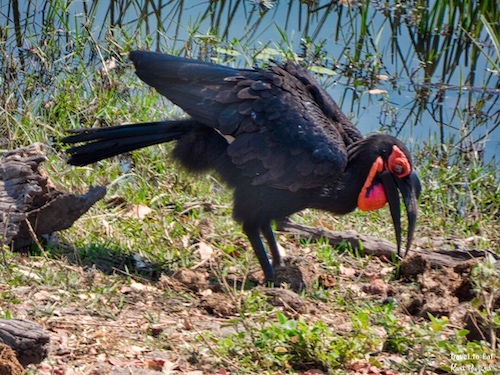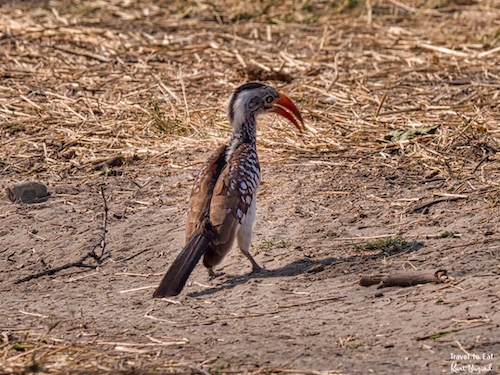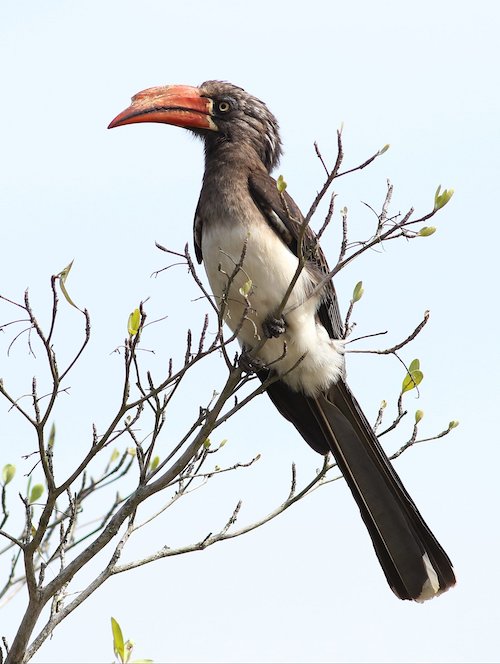
If you visit Botswana, you will undoubtedly encounter the red-billed hornbill seen above. Unlike most of the other birds, this one seems curious about humans and poses for pictures endlessly. The Hornsbill (Bucerotidae) include about 55 living species, though a number of cryptic species may yet be split, as has been suggested for the red-billed hornbill (seen above). Their distribution includes Sub-Saharan Africa and the Indian Subcontinent to the Philippines and the Solomon Islands, but no genus is found in both Africa and Asia. The most distinctive feature of the hornbills is the heavy bill, supported by powerful neck muscles as well as by the fused vertebrae. The large bill assists in fighting, preening, constructing the nest, and catching prey. There are two subfamilies: the Bucorvinae contain the two ground hornbills in a single genus, and the Bucerotinae contain all other taxa. Traditionally they are included in the order Coraciiformes (which includes also kingfishers, rollers, hoopoes and bee-eaters). In the Sibley-Ahlquist taxonomy, however, hornbills are separated from the Coraciiformes into an order of their own, Bucerotiformes, with the subfamilies elevated to family level.
Southern Ground Hornsbill

In Africa, southern ground-hornsbill are classified as ‘vulnerable’ by the IUCN, however, those in South Africa are classified as ‘endangered’ on the Red List of Threatened Species as only about 1500 individuals live within the country. Loss of habitat, loss of nesting trees, electrocution from transformer boxers and even, in some cases, killed for use in traditional medicine, have all contributed to the rapid decline of these odd but majestic birds. The southern ground hornbill (Bucorvus leadbeateri; formerly known as Bucorvus cafer), is one of two species of ground hornbill and is the largest species of hornbill. The other species of the genus Bucorvus is the Abyssinian ground hornbill, B. abyssinicus. Southern ground hornbills can be found from northern Namibia, Angola and Botswana to northern South Africa and southern Zimbabwe to Burundi and Kenya.
Coloration of Ground Hornsbill


The southern ground hornbill is characterized by black coloration and vivid red patches of bare skin on the face and throat (yellow in juvenile birds), which are generally believed to keep dust out of the birds eyes while they forage during the dry season. The beak is black and straight and presents a casque, more developed in males. Female southern ground hornbills are smaller and have violet-blue skin on their throats. Juveniles to six years old lack the prominent red pouch, but have a duller patch of grey in its place.

Other than the wattle (the red areas), the bird appears black in color, but in fact it has white primary feathers which are only visible in flight. The white tips of the wings (primary feathers) seen in flight are thus a good way to identify the birds. Another good identifier are the raucous bird calls. Southern ground hornbill groups are very vocal: contact is made by calls in chorus which can be heard at distances of up to 3 kilometres (about 2 miles). The calls allow each group to maintain its territories.
Characteristics of the Southern Ground Hornsbill



The Southern Ground Hornbill is a gigantic bird (sometimes referred to as a Turkey Buzzard – although it is neither a turkey nor a buzzard), and is the largest of the hornbill species. It can grow to a height of 4.5 feet (130 cm), with the males attaining a weight of up to 14 lbs (6 kgs) and the females being around 4 lbs (2 kgs) lighter. The birds are very territorial, with the entire family group of up to 10 individuals protecting a territory which can be many square miles. They are monogamous, pairing for the 30 – 40 years of their lives unless their mate dies. The southern ground hornbill’s loud voice and large size have made it a focal point in many traditional African cultures. Historically, there were strong taboos against killing of ground hornbills; however these have been weakened with the modernisation of Africa. For southern African cultures, the ground hornbill was a symbol of the arrival of the rainy season and this may have been a factor in above-mentioned hunting taboos.
Southern Ground Hornsbill Diet



The Southern ground hornbill forage on the ground, where they feed on reptiles, frogs, snails, insects and mammals up to the size of hares. Surprisingly, despite the fact that they often feed near water, Southern ground hornbills very rarely drink water. Their range is limited at its western end by the lack of trees in which to build nests. The individuals that we saw were particularly interested in snails.
Northern Ground Hornbill


The Abyssinian ground hornbill or northern ground hornbill (Bucorvus abyssinicus) is found north of the equator, and is one of two species of ground hornbill. The Abyssinian ground hornbill is found in Northern sub-Saharan Africa from southern Mauritania, Senegal and Guinea east to Eritrea, Ethiopia, north western Somalia, north western Kenya and Uganda. The Southern Ground Hornbill is slightly than the Northern Ground Hornbill, however the two are the largest species of hornbills found in Africa. The Abyssinian Ground Hornbill is a large, terrestrial hornbill with black body feathers and white primary feathers which are visible in flight. The Abyssinian ground hornbill lives in open grassland, in pairs or small family parties. The patrol their territory by walking and are reluctant fliers, usually only taking to the air when alarmed. The adult male has a patch of bare blue skin around the eye and an inflatable patch of bare skin on the neck and throat which is red, apart from the upper throat which is blue. The bill is long and black except for a reddish patch at the base of the mandible. On top of the bill there is a short open-ended black casque. The female is similar but smaller with any bare skin being wholly dark blue. Abyssinian ground hornbills are opportunist feeders, following larger herbivore herds and forest fires so that they can prey on small animals disturbed by the larger animals or flames. An individual hornbill can walk up to 6.8 miles (11 km) in a day, pouncing on and eating animals they come across. They have also been recorded digging for arthropods in the soil and attacking bee hives for honeycomb; they very rarely consume any plant matter.
Southern Red-Billed Hornsbill of Botswana

The Southern Red-Billed Hornbill (Tockus rufirostris) is a species of hornbill in the family Bucerotidae, which is native to the savannas and dryer bushlands of southern Africa. It is found from Malawi and Zambia to southern Angola, northeastern Namibia, Botswana, Zimbabwe, eastern Swaziland and northern South Africa (Transvaal and northern KZN province). It occurs in the upper Zambezi valley of Mozambique, but is mostly absent from the eastern lowlands.

Red-billed Hornbill is often seen in pairs, or in small family groups. During dry season, they may gather in large flocks of hundreds, around water holes and feeding areas. They move early in the morning, but they return to their regular roost in their territories at night. They roost in trees, on large branches or close to the trunk.

The Red-billed Hornbill is territorial. It defends permanent territory against its own species, but not others. Generally, Hornbills have overlapping territories. They are sedentary. Red-billed Hornbill runs rather than hops. It digs into the soil with its well adapted bill.
Southern Yellow Billed Hornbill


Yellow-billed hornbills (Tockus leucomelas) feed mainly on the ground, where they forage for seeds, small insects, spiders and scorpions. This hornbill species is a common and widespread resident of dry thornveldt and broad-leafed woodlands. They can often be seen along roads and water courses. It is a medium-sized bird, 48–60 centimetres (19–24 in) in length, 132–242 grams (0.291–0.534 lb) in weight and is characterized by a long yellow and down-curved beak. This beak is huge in comparison to its body and can account for up 1/6th of the entire body length. Male beaks are on average 90 mm long while female beaks are an average of 74 mm. Males are generally bigger than females but there is overlap between the sexes. The size difference of the beak is a fairly reliable way of differentiating sex in wild hornbills. The casque that characterizes all hornbills is of a very modest size in the southern yellow-billed hornbill. It is small, but it covers almost the entire length of the beak in males (less so in females), and may give the impression that they do not actually have a casque. I think the photos shown above are a female.
African Gray Hornsbill

Unfortunately, although I saw the African Gray Hornbill (Lophoceros nasutus), I missed the photo. It is a widespread and common resident breeder in much of sub-saharan Africa and into Arabia. The African grey hornbill has escaped or been deliberately released in to Florida, USA, but there is no evidence that the population is breeding and may only persist due to continuing releases or escapes. At 45 centimetres (18 in) in length, this is a large bird, although it is one of the smaller hornbills. It has mainly grey plumage, but the head, flight feathers and long tail are a darker shade. There is a white line down each side of the head and one on the back which is visible only in flight. The long curved bill is black and has a small casque and a creamy horizontal stripe.
Other Hornsbill



I hope you enjoyed the post.
References
http://www.birdlifebotswana.org.bw/conservation/ground_hornbill.html
https://www.sabisabi.com/wildfacts/southern-ground-hornbill/
